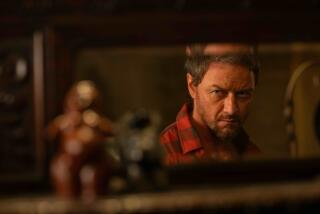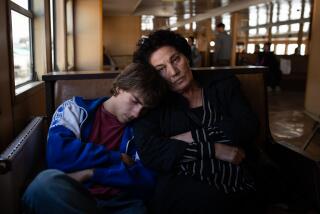‘Midsommar’ explained: The filmmakers unpack the sex, rituals and shocking ending
As exacting and detailed as Ari Aster is as a filmmaker, he’s surprisingly low-key about how to pronounce the title of his new film, “Midsommar.” While he, as many do, says “mid-so-mar,” others are going with “mid-summer.”
“That’s fine as well,” he said. “Either way.”
That atypical shot of easygoing energy also plays into the uncanny mix of restraint and chaos that gives “Midsommar” — Aster’s second film, and the follow-up to his acclaimed 2018 horror hit “Hereditary” — its shocking, disturbing power. A dark tale set mostly in the bright sunlight of a secluded Swedish village, the film tells the story of a young woman, Dani (Florence Pugh), who is gripped with grief after a horrific family tragedy finds little solace from her increasingly distant boyfriend, Christian (Jack Reynor).
When Christian begrudgingly invites Dani to join him and some fellow anthropology graduate students on a trip to Sweden to visit a community known as the Harga, their fates are mutually sealed. They become far more than just observers, but unwitting pawns in a series of rituals and customs that play out with ultimate consequences.
With no less than “Get Out” and “Us” maestro Jordan Peele declaring in a Fangoria interview that “Midsommar” has “some of the most atrociously disturbing imagery I’ve ever seen on film,” the movie has been generating a lot of conversation. Aster was racing to finish the film for its initial screenings just a few weeks ahead of release and almost immediately began doing extensive interviews. To get the film ready in time, his final mixing session was a 23-and-a-half hour day of work.
“It’s very surreal because we just finished the movie,” he said during a recent stop in Los Angeles. “There’s something very strange about finishing a movie and simultaneously having opinions raining down on it. It’s a relief that it’s not being panned.”
Warning: Major spoilers for “Midsommar” follow. Stop reading if you haven’t seen the film and want to stay in the dark.
THE ORIGINS OF THE HARGA
The end credits for “Midsommar” feature the unusual credit “Concept of the Hargas by Martin Karlqvist and Patrik Andersson.” The origins of the film came when Aster was approached by Andersson, a Swedish producer, and his friend Karlqvist, with an idea for a Swedish-set folk-horror tale. After working with them on research of Swedish folk traditions, as Aster sat down to write the script, he was drawn to take it in another direction following a tumultuous romantic break-up.
The intense detail of the Harga culture naturally leads to questions of just how much of it has some basis in reality. Aside from his research with Karlqvist, Aster also worked with Henrik Svensson, a musician and artist in Sweden. After Svensson began assisting with further research, he would eventually make his debut as a feature film production designer, bringing the Harga village to life in Hungary, where most of the film was shot.
“This is not Swedish history. This is folklore,” Aster is careful to note.
“All of them are true,” Svensson said on the phone from Stockholm regarding the rituals depicted in the movie having at least some basis in historical fact, such as the oversized mallet used to finish the job when an older couple attempts suicide by jumping from a cliff.
“The mallet, we did a replica of the mallet from a museum we saw in Stockholm,” he said. “When they jump from a cliff that was the custom until not so long ago, for elderly people. But they mainly got pushed. And many of the cliffs are now historic sites for everyone to see. So it’s true, all of it. And that’s the scary part.”
THE BREAKUP
“Hereditary” fused the occult tumult of “Rosemary’s Baby” with the family drama of “Ordinary People.” For “Midsommar,” Aster has created a conjoined hybrid of “The Wicker Man” style folk horror with the painful examination of heartbreak as in “Modern Romance.”
“For me, the film is incidentally a folk horror film. If anything, this is my attempt at making a big operatic breakup movie that feels the way a breakup feels,” said Aster. “That sort of makes literal those feelings, where a breakup can feel apocalyptic, like the world is ending. And so there’s a pleasure in taking a movie to that extreme.
“Anybody watching the trailer for ‘Midsommar,’ you probably know where it’s going, right? These people are going to be sacrificed,” he said. “And so that made it the least interesting thing for me. It was about getting to that inevitable ending in a way that feels emotionally surprising. And my way in was by kind of working through my breakup.”
However, Aster is conscientious to point out, “Nobody in the movie is a surrogate for my ex-girlfriend. It’s not like this is what I want to do to my ex, but there is a feeling of you want to set fire to that part of yourself and that part of your life and move on clean because it’s so painful.”
THE HALLUCINATIONS
Before the Americans even arrive to the main village, they take psychedelic mushrooms, making them less trusting of what is happening around them and exacerbating the distance and miscommunication between Dani and Christian. Once they are among the Hårga, they are frequently given tea which is likewise laced with some kind of hallucinatory substance. The image of the film often subtly warps as the actors at times seem a bit dazed as if they are off on their own separate trips.
“Can you think of any film that you’ve watched that has as accurately represented the experience of a mushroom trip?” Reynor said.
As to capturing the spaced-out sensations of the drug in his performance, he responded, “I’ve done my fair share of psychedelic drugs. I’ve had my share of mushroom trips.
“We had some conversations with the other members of the cast, some of them, who hadn’t had mushroom trips before and talked about the experiences of it and how it feels,” he added. “And I felt like by and large, all of the performances really hit the right beats of what it’s like to be under the influence of mushrooms.”
Aster said it was a “long process of trial and error” to find the exact nuance of the visuals. “There are some things we did in camera, but for the most part we had visual effect artists doing that in post,” he said. “I’m sure for some of those shots we got to the point where we had 60 versions. In one iteration the tripping was way too distracting and you’re not paying attention to the characters, and then you brought it down to the point where if you are paying attention to the characters, you’ll never notice the tripping effects.
“We settled on that the week before we screened the film,” he added. “I hope we landed at the right place.”
THE COSTUMES AND THE MURALS
The costumes of the Harga village also tell a story. Costume designer Andrea Flesch, who worked on such intricately detailed films as “The Duke of Burgundy” and “Colette,” ordered buttons from Sweden and antique linen sourced from Hungary and Romania. Many pieces were hand-embroidered, while others were painted or printed, with costumes used to signify different families and even different jobs within the community, such as servers or musicians. Each costume was given an individual runic symbol to identify the characters.
“It’s a classic Swedish cut and design,” said Flesch, in a call from Hungary. “but Ari had the decision that everybody’s in white and that these people are making their clothes for themselves. So all the costumes had to be different by little details, it’s all handmade both in real life and in the story of the film. It’s as if they made it just for themselves.”
Among the many background details for audiences to catch on repeat viewing are the murals and tapestries that are seen all around the village — which presage many of the events of the film.
“I like things that really encourage a more active audience engagement,” said Aster, “and if there’s a way to provide exposition in a way that makes the audience do a certain amount of work — that encourages them to lean in towards the movie as opposed to handing people that information — it’s just more fun.”
“We never talked about giving away too much,” said Svensson. “Because we always thought that this film has no real surprises in it. You know from the beginning more or less what’s going to happen. And I never thought people would see that much [of the murals]. It’s a lot of paintings, but most of them are in the background or out of focus. So we could really push it.”
THE SEX SCENE
One of the things revealed on a tapestry is the love ritual that is performed on Christian, meant to bind him to a specific young woman for conception and procreation. This leads to one of the most disturbing scenes in the film, in which a drugged-out Christian is brought in to have sex with the young woman in front of a chorus of chanting naked women. The scene is unnerving and darkly funny; its intricate choreography akin to that of a musical number.
For Reynor, the scene brought up a mix of emotions. He was attempting to keep up the spirits of the background players, none of whom spoke English, during the more than 16-hour final day of shooting, while also conveying empathy and understanding to actress Isabelle Grill, who was shooting her first feature film, in the scene with him. All while grappling with his own feelings of vulnerability in shooting an intense scene completely naked — the likes of which are usually experienced by women in horror films.
“You don’t see that stuff happening to male actors in films very much,” said Reynor. “Although it’s not pitched at the same level of violence, it does flip that dynamic on its head a little bit, and it was an opportunity for me to experience something of that as a male actor.
“And to shoot a scene where I was going to have to be exposed — I advocated for as much full-frontal nudity as possible,” he added. “I really wanted to embrace the feeling of being exposed and the humiliation of this character. And I felt really, really vulnerable, more than I had actually even anticipated.”
THE ENDING
As “Midsommar” has been making its way to audiences, Aster and Reynor have noticed that people are divided in their responses toward Dani and Christian and their respective fates.
“In the context of the relationship, is it what the character deserves?” asks Reynor. “Symbolically, yes, it is. But audiences seem to be polarized about their feelings, some people empathize with the character and then other people just feel, ‘Nope, that’s what you get.’
“I feel like the film says a lot about its audience,” he added, “You know as much about the audience that watches it as it says about anything else.”
“I see the film as being a perverse wish fulfillment fantasy,” said Aster. “Christian and his friends, they’re all walking into a folk horror movie and that’s what the movie is going to be for them. But for Dani, by the end it’ll be revealed that in fact the movie is a fairy tale only for her.”
SIGN UP for the free Indie Focus movies newsletter »
Follow on Twitter: @IndieFocus
More to Read
Only good movies
Get the Indie Focus newsletter, Mark Olsen's weekly guide to the world of cinema.
You may occasionally receive promotional content from the Los Angeles Times.











